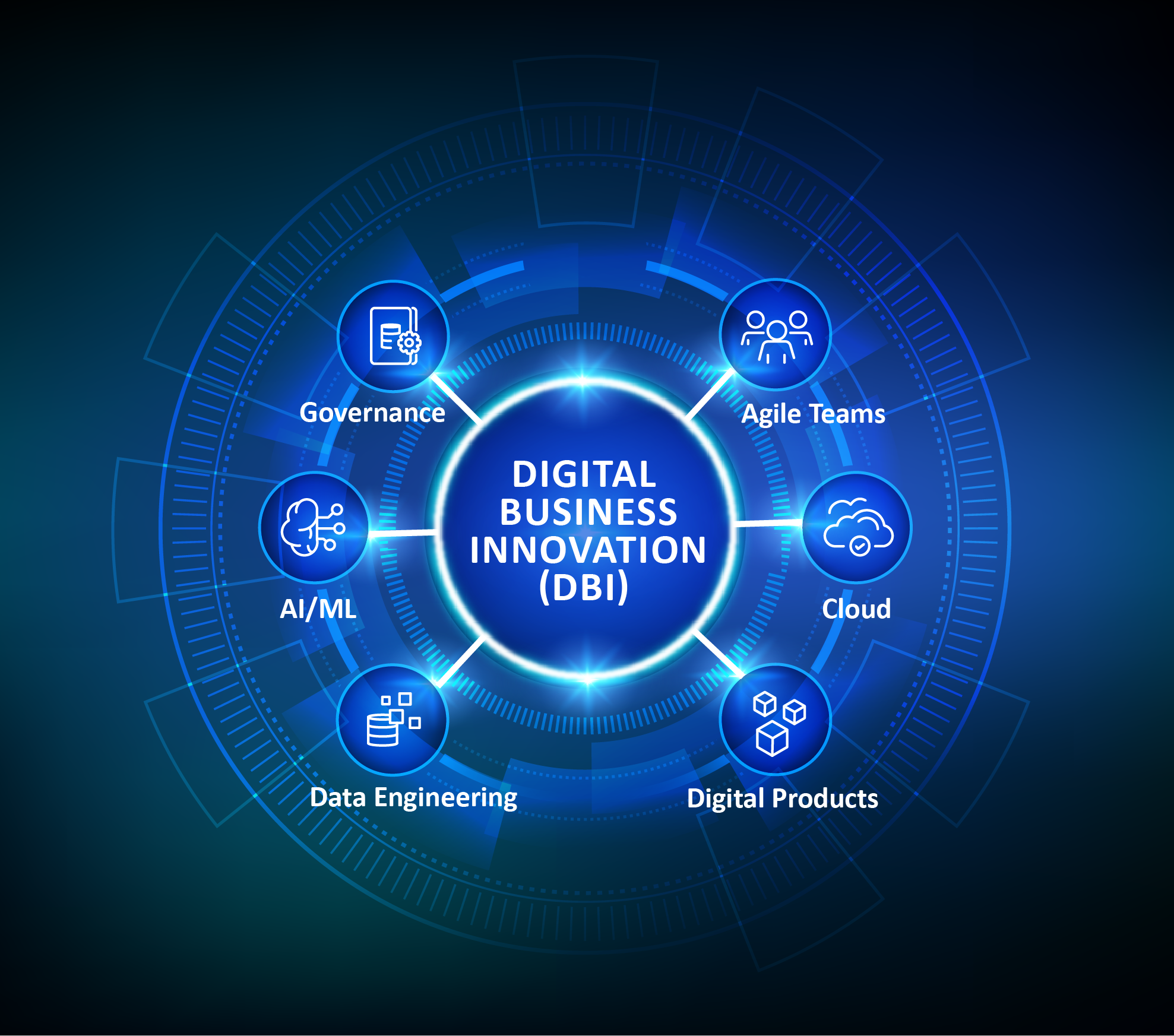Introduction to Digital Business Innovation Methodology (DBIM)
What is Digital Business Innovation (DBI)?
Digital Business Innovation (DBI) is the framework and continuous practice of reimagining business models, customer experiences, and operational efficiencies by leveraging digital capabilities at speed and scale. The core purpose of digital business innovation is to leverage digital technologies, data, and AI to create value for customers and the business at speed and scale in a sustainable manner. It’s about making innovation scalable, measurable, and repeatable—turning strategy into software, ideas into assets, and disruption into an opportunity.
In today’s hyper-competitive landscape, digital business innovation is not just a strategic growth differentiator; it's a survival strategy.

Think of DBI as your “always-on” innovation engine. Unlike traditional transformation, DBI is not a one-time initiative — it is a continuous innovation capability embedded within the enterprise. See Traditional Innovation Vs DBIM.
Twin Accelerators of Digital Business Innovation
DBI adopts a “business-first” agile approach to innovation. Instead of “technology-first” prolonged project cycles, it promotes short, iterative sprints focused on high-value business outcomes. Each cycle is tied to a business use case and supported by technical enablers through the digital innovation sandbox.
At the heart of DBI lie:
-
Digital Business Innovation Methodology (DBIM): A structured and repeatable framework for developing and implementing new digital and data products, solutions, processes, or services that create value at speed and scale. This is designed to break down complex problems into manageable, high-impact use cases, deliver tangible outcomes at speed by developing, orchestrating, and implementing a bite-sized use-case-driven approach. DBIM ensures that innovation is purposeful, traceable, and aligned with enterprise goals.
-
Digital Business Innovation Sandbox (DBIS) — A ready-to-use, cloud-based platform that provides integrated tools, data services, and technology stack to quickly experiment, validate, and scale ideas from concept to working proof-of-concept (POC). It empowers cross-functional teams to test assumptions, build MVPs, and accelerate go-to-market readiness. See Calibo’s Digital Innovation Sandbox – Accelerating Innovation.
Digital Innovation: A Competitive Imperative
In today’s digital economy, innovation speed, adaptability, and customer relevance are your competitive advantage, setting leaders apart from laggards.
According to Forrester, 77% of the U.S. technology decision-makers in digital and digital strategy anticipate budget increases for consumer-facing digital products and services in 2024, underscoring the strategic importance of digital innovation.

-
Speed Wins: Enterprises that can release digital capabilities faster outcompete slower competitors whether it's a new product, a new service, or a customer feature.
-
Markets Change Fast: Innovation is not a one-time event. It’s a cycle that must evolve with new data, trends, and user expectations.
-
Ideas Are Plentiful—Execution is Hard: Most organizations don’t lack ideas. They lack a consistent way to evaluate, prioritize, and deliver those ideas.
-
Innovation in Silos Kills Value: Without a unified approach, different departments may build redundant systems, chase low-impact projects, or compete for limited IT resources.
In this context, Calibo’s DBIM empowers organizations to build innovation pipelines instead of bottlenecks—enabling faster delivery, smarter decisions, and scalable results— giving them a tangible edge in the market.
Traditional Innovation vs. DBIM
Many digital transformation efforts falter because they rely on fragmented, technology-driven approaches where business alignment and ROI measurement come too late—or not at all. Calibo’s Digital Business Innovation Methodology (DBIM) flips this model by embedding business value, cross-functional alignment, and outcome orientation from day one. This comparative view illustrates how DBIM addresses the shortcomings of traditional innovation models and establishes a structured, value-driven alternative that organizations can rely on for measurable impact.
| Traditional Digital Innovation | Digital Business Innovation (DBIM) |
|---|---|
| Tech-led; business consulted later | Business-first; value defined up front |
| Success = project go-live | Success = business outcome + ROI |
| Often driven by platform or vendor choices | Driven by use case value, feasibility, and business alignment |
| Delivery timelines are long and vague | Fixed 8–10-week sprints with defined checkpoints |
| Reuse is incidental and undocumented | Reuse is intentional, traceable, and encouraged |
| Governance slows down execution | Governance is lightweight and embedded in each step |
| KPIs tracked at the end (if at all) | KPIs and ROI tracked from the beginning |
Definition and Key Concepts
Here’s a quick primer on essential terms you will come across frequently in the explanation and flow of the Calibo Digital Business Innovation Methodology (DBIM):
| Term | Definition |
|---|---|
| Digital Business Innovation (DBI) | The practice of leveraging technology, data, and design thinking to reimagine processes, products, and business models for scalable, measurable, and repeatable value creation. |
| DBIM | Calibo’s Digital Business Innovation Methodology, a framework to deliver business outcomes via agile, orchestrated use case execution. It delivers the most seamless experience and accelerated outcome by leveraging Calibo’s Digital Innovation Sandbox. |
| Use Case | A discrete, high-impact opportunity tied to a specific business goal, solvable through digital execution (for example, hyper-personalized product recommendation in a digital commerce ecosystem). |
| Use Case Orchestration | The structured coordination of people, process, and technology across a use case’s life cycle—from discovery to deployment. |
| Internal Marketplace | A centralized tenant-specific vault of reusable business components (data models, APIs, workflows, ML models) created through use case execution. |
| Productization | The process of scaling validated use cases into reusable, packaged solutions that can be adopted by multiple teams or customers. |
Why Are Enterprises Struggling to Innovate at Scale?
Despite investing heavily in digital transformation, many enterprises hit a wall when it comes to scaling innovation. Common challenges include:
-
Big Bang Projects that Stall: Large, monolithic programs often promise long-term value but deliver little in the near term, resulting in delayed impact, cost overruns, or eventual abandonment.
-
Silo Teams and Tools: Innovation efforts are often scattered across business units, with no shared system for tracking ideas, value, or delivery.
-
Lack of True Agile Engineering Rigor: Even great ideas get lost in translation due to poorly defined requirements, unclear ownership, or weak alignment with business strategy.
-
Less Focus on Reusable Assets: Without a shared and reusable asset strategy, teams end up solving the same problems repeatedly, which increases costs and slows down delivery.
-
Innovation Stagnation: Missed market windows, legacy inertia, and over-reliance on central IT contribute to lost momentum and reduced agility.
From Transformation Projects to Innovation Pipelines
Traditional digital transformation efforts often aim to overhaul entire systems in one sweep, which is a risky, time-consuming approach. A smarter alternative is to break down big transformation goals into executable digital use cases with tangible business outcomes, each designed to be delivered in smaller sprints, 8-10 weeks. This shift—from slow, siloed projects to a continuous pipeline of business-aligned innovation—unlocks early wins and builds organizational confidence.
Reimagining Digital Business Innovation with Calibo’s DBIM
Calibo’s Digital Business Innovation Methodology (DBIM) provides a structured, outcome-driven framework for orchestrating high-value digital use cases—from discovering the use cases to full deployment. Rather than relying on fragmented tools and unrepeatable processes, DBIM systematizes innovation as a repeatable pipeline—fuelled by business priorities, governed by clear checkpoints, and accelerated by Calibo’s flagship Digital Innovation Sandbox.
DBIM helps enterprises:
-
Rapidly identify and prioritize the high-impact use cases
-
Design scalable digital solutions with cross-functional alignment
-
Execute and deploy in 8-10-week cycles using integrated tools and modern data stack
-
Reuse validated components through shared repositories
-
Scale proven solutions across teams, regions, and lines of business
-
Continuously track ROI, KPIs, and adoption metrics
DBIM Is a Game-Changer
Unlike traditional methods or ad-hoc innovation platforms, DBIM is designed for enterprises that want to deliver real, repeatable value fast. It bridges the gap between strategy and execution by:
-
Enabling modular innovation instead of monolithic change
-
Driving adoption through visibility, traceability, and ownership
-
Ensuring continuity from Idea to MVP to productization and scaling
-
Empowering decentralized teams with centralized governance
With Calibo Digital Innovation Sandbox, your teams gain a self-service, end-to-end environment that connects business ideas & use cases, product planning, DevOps, and data engineering in one unified experience.
Why DBIM Now?
-
Challenges in Traditional Transformation Programs
Transformation programs often suffer from bloated scopes, long timelines, and unclear ROI. By the time solutions are deployed, they’re already outdated or often misaligned with evolving market needs
Gartner reports that only 48% of enterprise-wide digital initiatives meet or exceed business outcome targets, highlighting the need for more agile and responsive innovation approaches.
-
Fragmented Ownership and Delayed Value
Ownership often lives in silos — business owns strategy, scope and outcomes, IT owns delivery. This disconnection delays time-to-value and leads to fragmented solutions. DBIM bridges this gap through cross-functional squads and an integrated sandbox that aligns priorities.
-
Lack of Governance and Strategy Alignment
Without strategic alignment, innovation becomes tactical — lots of pilots, little impact. DBIM ensures that use cases are aligned with business strategy and governed with clear KPIs, ensuring investment in the right bets.
-
Real-World Indicators of Innovation Stagnation
Some signs of stalled innovation include:
-
Too many proofs-of-concept, not enough pilots
-
Long lead times for basic integrations
-
Teams unsure of where to take ideas next
-
High dependency on central IT for experimentation
-
PRO TIP:
A digital innovation sandbox fosters collaboration and joint accountability. Co-create, don’t hand off.
Gartner identifies key CIO challenges for 2025, including scaling AI from early exploration to delivering measurable value, emphasizing the urgency for effective innovation strategies.
Core Principles of DBIM
The Digital Business Innovation Methodology (DBIM) is built on a set of core principles that drive sustained, value-centric innovation. These principles provide a structured yet agile approach to transforming business challenges into scalable digital solutions. From prioritizing high-impact use cases and enabling rapid MVP delivery to fostering reusable assets, data-centric design, and cross-functional collaboration—DBIM ensures that innovation is fast, measurable, and aligned with strategic business goals. The following foundational principles guide every step of the DBIM journey.
-
Use Case-Driven Innovation
DBIM starts with the business challenge, not the technology. Use cases are prioritized by business impact, strategic alignment, and technical feasibility, ensuring relevance, measurable outcomes, and value realization from Day 1.
-
8-10-Week Agile Delivery Cycles with Dedicated Scrum Teams
Short, focused sprints drive momentum. Each cycle aims to move from concept to working demo or MVP — rapidly tested in the sandbox environment and refined through feedback loops for faster learning and validation.
-
Standardized, Scalable Operating Models
Consistency matters. DBIM uses a standardized operating model across innovation squads and defines how use cases are selected, how solutions are developed, and orchestrated to achieve speed and consistency.
-
Reusable Digital Assets
One of the core deliverables of DBIM is to create reusable assets so that the need for reinventing the wheel is avoided. This truly accelerates the time to value.
-
Governance without Bottlenecks
Each phase—Discovery, Rationalization, Prioritization, Development, Deployment—is governed through lightweight, transparent workflows, ensuring oversight without slowing down innovation velocity.
-
Data-Centric Innovation
DBIM treats data as a first-class citizen. Every use case leverages structured data pipelines for better decision-making, operational efficiency, and integration into digital products.
-
Value Hypothesis Validation
Each use case must define clear KPIs and a value hypothesis early in the process. Success is measured by actual business outcomes, not just delivery milestones.
-
Cross-Functional Collaboration by Design
DBIM brings business teams, product managers, architects, data engineers, QA, and development teams onto a shared platform for continuous alignment, faster handoffs, and collective ownership of outcomes.
-
Marketplace-Ready Mindset
Use cases are developed with the mindset that, once successful, they can be published to an internal or external Marketplace—promoting broader adoption, reuse, and monetization possibilities across the organization.
-
Continuous Improvement and Scaling
Post-MVP, use cases are not just deployed and forgotten. DBIM emphasizes KPI tracking, user feedback, enhancement backlogs, and scaling strategies to extend impact and achieve sustainable innovation growth.
|
What's next? Calibo’s Digital Innovation Sandbox – Accelerating Innovation
|